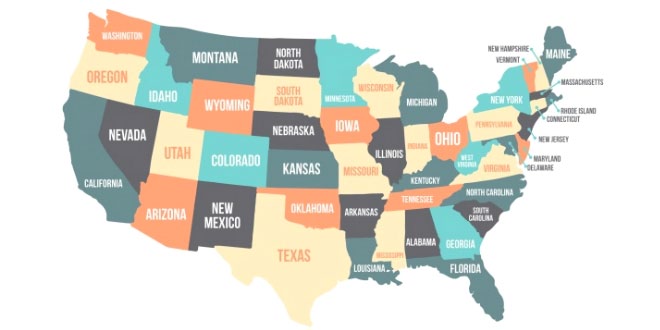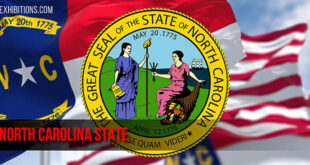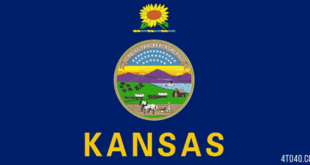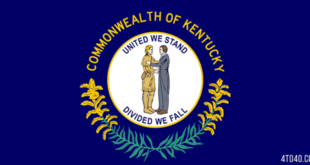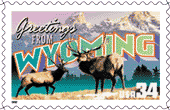 Montana is to the north, Nebraska and South Dakota to the east, Colorado and Utah to the south, and Idaho to the west. Rich in energy resources, Wyoming became a territory in 1868 and attained statehood on July 10, 1890. Its name derives from a Delaware Indian term meaning “at the big plains”, and its nickname, “Equality State”, was earned in 1869 when Wyoming women became the first in the United States to win the right to vote. CHEYENNE, the capital, was founded in 1867 and is one of the state’s earliest permanent settlements.
Montana is to the north, Nebraska and South Dakota to the east, Colorado and Utah to the south, and Idaho to the west. Rich in energy resources, Wyoming became a territory in 1868 and attained statehood on July 10, 1890. Its name derives from a Delaware Indian term meaning “at the big plains”, and its nickname, “Equality State”, was earned in 1869 when Wyoming women became the first in the United States to win the right to vote. CHEYENNE, the capital, was founded in 1867 and is one of the state’s earliest permanent settlements.
Wyoming State: Land & Resources
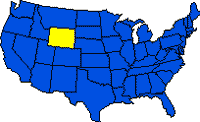 Located at an average elevation of 2,042 m (6,700 ft), Wyoming is higher than any other state except Colorado. Two-thirds is occupied by rolling plains at elevations between 1,130 m (3,700 ft) and 1,860 m (6,100 ft); about one-third is part of the rugged ROCKY MOUNTAINS and rises to more than 3,000 m (10,000 ft) and in places to more than 3,900 m (13,000 ft). The plains of eastern Wyoming are broken by the prominent BLACK HILLS and Devils Tower volcanic neck and are part of the GREAT PLAINS.
Located at an average elevation of 2,042 m (6,700 ft), Wyoming is higher than any other state except Colorado. Two-thirds is occupied by rolling plains at elevations between 1,130 m (3,700 ft) and 1,860 m (6,100 ft); about one-third is part of the rugged ROCKY MOUNTAINS and rises to more than 3,000 m (10,000 ft) and in places to more than 3,900 m (13,000 ft). The plains of eastern Wyoming are broken by the prominent BLACK HILLS and Devils Tower volcanic neck and are part of the GREAT PLAINS.
The plains of the Wyoming Basin (southwestern Wyoming) and the Big Horn Basin (north central Wyoming) are similar in appearance and economy to those of the Great Plains but physiographically are part of the Rockies. The Central Rockies dominate Wyoming north and west of the Wyoming Basin and include the Big Horn Mountains and Teton, Absaroka, Wind River, Salt River, and Bear River ranges. The Laramie and Medicine Bow mountains along the southern border are part of the Southern Rockies. The CONTINENTAL DIVIDE traverses Wyoming. It divides to enclose the Great Divide Basin near Rawlins and reaches its lowest point of 2,301 m (7,550 ft) at South Pass.
Climate
Wyoming has a cool and dry climate because of its elevation and the “rain shadow effect” that causes most precipitation to fall in the mountains and leaves lowland areas with semidesert and desert conditions. Mean annual rainfall averages 305 mm (12 in) for the state as a whole but ranges from 1,016 mm (40 in) in the mountains to less than 127 mm (5 in) in the Red Desert of the Great Divide Basin. About 60% of all precipitation falls in summer.
Mean high temperatures in July reach between 29 deg C (85 deg F) and 32 deg C (90 deg F) and fall to between 10 deg C (50 deg F) and 16 deg C (60 deg F) at night, with cooler temperatures and occasional frosts in the mountains. January temperatures average minus 12 deg to minus 2 deg C (10 deg to 28 deg F). Periodic warm spells give way to cold waves and periods with below minus 18 deg C (0 deg F). The highest temperature ever recorded in Wyoming is 46 deg C (114 deg F) and occurred on July 12, 1900, at Basin; the lowest is minus 53 deg C (minus 63 deg F), recorded at Moran on Feb. 9, 1933.
Historical Sites
Important historical sites include the remains of a fur-trading and military fort of the Old West at Fort Laramie National Historic Site (near Torrington), restorations at Fort Bridger State Historic Site, and remains of old Fort Fetterman northwest of Douglas. Ruts and other remains of the old Oregon, Overland, and Bozeman trails can be seen in places.
Tourism
Tourism is a leading source of income in Wyoming. Major attractions are YELLOWSTONE NATIONAL PARK and GRAND TETON NATIONAL PARK. Other attractions include Devils Tower National Monument; Flaming Gorge National Recreation Area; Horseshoe Bend and Big Sandy recreation areas; and Boysen, Buffalo Bill, Glendo, Guernsey, Hot Springs, Keyhole, and Seminoe state parks. Resorts are in and around the JACKSON HOLE, Cody, Wind River Range, Big Horn Mountains, and Saratoga Valley.
Credit: theworldtravelguy.com
Wyoming State: History
Archaeological findings indicate that Wyoming was occupied as early as 7000 BC, but little is known of the state’s inhabitants before 1800. During the early 19th century travelers encountered CROW, BLACKFOOT, UTE, FLATHEAD, SHOSHONI, CHEYENNE, and ARAPAHO Indians; and SIOUX moved in during the 19th century. All were nonagricultural and lived primarily on buffalo and other hunted animals. The Indians were important partners in the early FUR TRADE but became increasingly hostile as their hunting lands were destroyed. Except for the Shoshoni and Arapaho, now on the Wind River Reservation, all were driven from the state by 1878.
Early explorers were fur traders. Some historians question whether Francois and Louis Joseph de La Verendrye were the first to arrive when they explored parts of the West in 1742-43. In 1803 the Louisiana Purchase transferred Wyoming to the United States, and in 1805 the French-Canadian fur trader Francois Antoine Larocque became the first authenticated visitor, trading furs with the Indians in the Powder River region.
John COLTER became the first explorer of western Wyoming in 1807. Other early explorers were Wilson Price Hunt, who led the Overland Astorians westward through Wyoming in 1811; Robert Stuart, who led the first party eastward across Wyoming in 1812 via the South Pass; and Jacques La Ramie, for whom Fort Laramie and the city of Laramie were later named. The fur trade expanded rapidly during the 1820s and brought to Wyoming William H. ASHLEY and such colorful MOUNTAIN MEN as James (“Jim”) BRIDGER, Jedediah SMITH, William L. (“Bill”) Sublette, David E. Jackson, and Robert Campbell. Increasing competition with the Hudson’s Bay and American Fur companies depleted the beaver catch and brought an end to the fur trade by 1840.
Westward-bound traffic became important after John C. FREMONT led a government expedition across Wyoming in 1842, and many mountain men found work as guides and supply men on newly developing trails to the West.
The principal trail followed the Platte and Sweetwater rivers and crossed the Continental Divide at South Pass. This became known as the OREGON TRAIL and, after Brigham Young led the Mormon migration through Wyoming into Utah in 1847, as the Mormon Trail. It became known as the California Trail after 1849 and was used by the pony express (1860-61) and by stagecoaches until the Overland Trail opened farther south. Treaties with the Indians and cavalry stations at Forts Bridger, Laramie, Fetterman, and elsewhere protected the early travelers, but attacks increased during the Civil War after the BOZEMAN TRAIL in northeastern Wyoming was blazed across Indian hunting grounds in 1863. Two major Wyoming battles during the ensuing hostilities were the Fetterman Massacre of 1866, in which Lt. Col. W. J. Fetterman and 81 men from Fort Phil Kearny were killed by Sioux Indians under Chief Red Cloud, and the Wagon Box fight of 1867, in which more than 1,000 Sioux were driven back by Capt. James Powell.
Territorial status and the name Wyoming were first proposed in 1865 by Ohio congressman James M. Ashley. In 1868, after defeat of efforts to name the territory Lincoln, the new territory of Wyoming was created from lands once part of the Oregon, Dakota, Utah, and Idaho territories. Permanent settlement began with the construction of the Union Pacific Railroad across the southern part of the state in 1867-69. A string of communities sprang up to serve the rail construction crews, some of which–including Cheyenne, Laramie, Green River, and Evanston–developed as early urban centers. Early pioneer settlers concentrated on running the railroad, exploiting coal and other minerals, and running livestock on the open range. Cattle ranching became big business, despite large losses of stock in the severe winter of 1887-88. Violent range wars developed between cattle and sheep men, and increased cattle rustling brought violent reprisals such as those of the Johnson County War in 1892. Few farmers settled in Wyoming under the Homestead Act of 1862, but ranchers and cowboys began filing claims to and fencing the better range and waterholes legally and illegally toward the end of the century.
In 1890, after nearly 22 years as a territory, Wyoming became the 44th state to join the Union. No large industries or population centers developed. Petroleum (first produced during the 1880s and a boom industry after 1910), trona (discovered in 1938), and uranium (discovered in 1918 and important since the 1950s) were, along with tourism, the principal activities until coal exploitation and power generation gained prominence during the 1970s. Some Wyoming residents expressed concern over industry’s destruction of the state’s scenic and environmental assets and use of water resources, but the “colonial-type economy” is likely to continue well into the 21st century.
Wyoming State: Land
- Area: 253,349 sq km (97,818 sq mi); rank: 10th.
- Capital and largest city: Cheyenne (1990 pop., 50,008).
- Counties: 23.
- Elevations: highest–4,207 m (13,804 ft), at Gannett Peak; lowest–945 m (3,100 ft), at the Belle Fourche River.
 Kids Portal For Parents India Kids Network
Kids Portal For Parents India Kids Network
